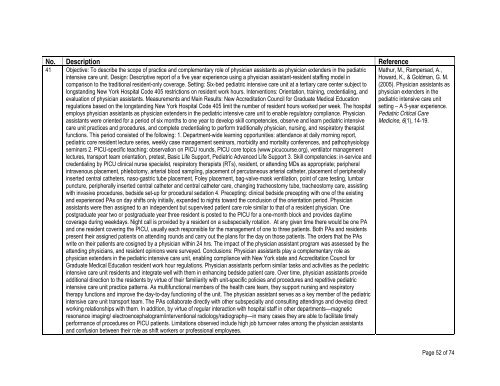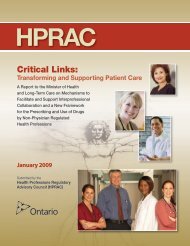Physician Assistants: A Literature Review - Health Professions ...
Physician Assistants: A Literature Review - Health Professions ...
Physician Assistants: A Literature Review - Health Professions ...
- No tags were found...
You also want an ePaper? Increase the reach of your titles
YUMPU automatically turns print PDFs into web optimized ePapers that Google loves.
No. Description Reference41 Objective: To describe the scope of practice and complementary role of physician assistants as physician extenders in the pediatricintensive care unit. Design: Descriptive report of a five year experience using a physician assistant-resident staffing model incomparison to the traditional resident-only coverage. Setting: Six-bed pediatric intensive care unit at a tertiary care center subject tolongstanding New York Hospital Code 405 restrictions on resident work hours. Interventions: Orientation, training, credentialing, andevaluation of physician assistants. Measurements and Main Results: New Accreditation Council for Graduate Medical Educationregulations based on the longstanding New York Hospital Code 405 limit the number of resident hours worked per week. The hospitalemploys physician assistants as physician extenders in the pediatric intensive care unit to enable regulatory compliance. <strong>Physician</strong>assistants were oriented for a period of six months to one year to develop skill competencies, observe and learn pediatric intensivecare unit practices and procedures, and complete credentialing to perform traditionally physician, nursing, and respiratory therapistfunctions. This period consisted of the following: 1. Department-wide learning opportunities: attendance at daily morning report,pediatric core resident lecture series, weekly case management seminars, morbidity and mortality conferences, and pathophysiologyseminars 2. PICU-specific teaching: observation on PICU rounds, PICU core topics (www.picucourse.org), ventilator managementlectures, transport team orientation, pretest, Basic Life Support, Pediatric Advanced Life Support 3. Skill competencies: in-service andcredentialing by PICU clinical nurse specialist, respiratory therapists (RTs), resident, or attending MDs as appropriate; peripheralintravenous placement, phlebotomy, arterial blood sampling, placement of percutaneous arterial catheter, placement of peripherallyinserted central catheters, naso-gastric tube placement, Foley placement, bag-valve-mask ventilation, point of care testing, lumbarpuncture, peripherally inserted central catheter and central catheter care, changing tracheostomy tube, tracheostomy care, assistingwith invasive procedures, bedside set-up for procedural sedation 4. Precepting: clinical bedside precepting with one of the existingand experienced PAs on day shifts only initially, expanded to nights toward the conclusion of the orientation period. <strong>Physician</strong>assistants were then assigned to an independent but supervised patient care role similar to that of a resident physician. Onepostgraduate year two or postgraduate year three resident is posted to the PICU for a one-month block and provides daytimecoverage during weekdays. Night call is provided by a resident on a subspecialty rotation. At any given time there would be one PAand one resident covering the PICU, usually each responsible for the management of one to three patients. Both PAs and residentspresent their assigned patients on attending rounds and carry out the plans for the day on those patients. The orders that the PAswrite on their patients are cosigned by a physician within 24 hrs. The impact of the physician assistant program was assessed by theattending physicians, and resident opinions were surveyed. Conclusions: <strong>Physician</strong> assistants play a complementary role asphysician extenders in the pediatric intensive care unit, enabling compliance with New York state and Accreditation Council forGraduate Medical Education resident work hour regulations. <strong>Physician</strong> assistants perform similar tasks and activities as the pediatricintensive care unit residents and integrate well with them in enhancing bedside patient care. Over time, physician assistants provideadditional direction to the residents by virtue of their familiarity with unit-specific policies and procedures and repetitive pediatricintensive care unit practice patterns. As multifunctional members of the health care team, they support nursing and respiratorytherapy functions and improve the day-to-day functioning of the unit. The physician assistant serves as a key member of the pediatricintensive care unit transport team. The PAs collaborate directly with other subspecialty and consulting attendings and develop directworking relationships with them. In addition, by virtue of regular interaction with hospital staff in other departments—magneticresonance imaging/ electroencephalogram/interventional radiology/radiography—in many cases they are able to facilitate timelyperformance of procedures on PICU patients. Limitations observed include high job turnover rates among the physician assistantsand confusion between their role as shift workers or professional employees.Mathur, M., Rampersad, A.,Howard, K., & Goldman, G. M.(2005). <strong>Physician</strong> assistants asphysician extenders in thepediatric intensive care unitsetting – A 5-year experience.Pediatric Critical CareMedicine, 6(1), 14-19.Page 52 of 74
















